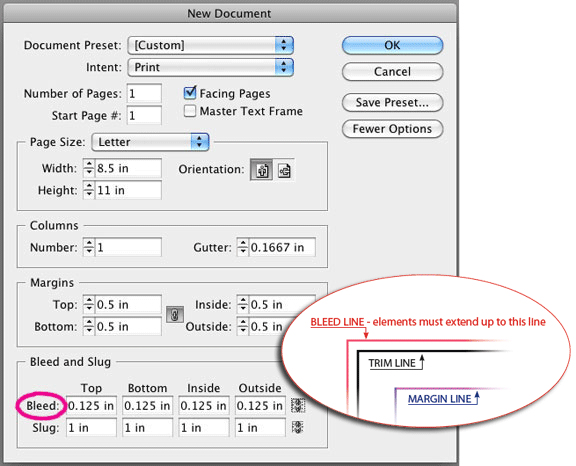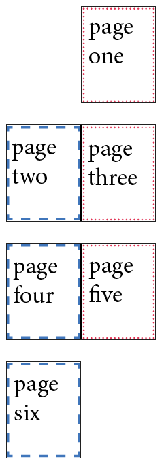Naming Conventions
• Spot colors (PMS) should be named exactly the same in all page files and linked image files.
• Maintain consistent naming conventions for your files, including the folio(s).
• Periods, dashes and underscores may be used in names, but avoid using the following special characters: / \ : * ? “ < > | ( )
Page Construction
• It is best to create your document as single pages, set up as facing pages, built to their actual trim size.
• Elements that bleed off of the page must extend 1/8” over the edge of the page on all four sides.
• Important live matter, including all type, must be a minimum of 1/4” inside the final trim to ensure that no essential information is trimmed off.
• Drill holes (wire-o or 3-hole drill) should be 3/8” from spine. Live matter should be at least 1/8” from drill holes.
• If constructing pages that will have versions, contact your Leafa Printing CSR for specifications on how to best build and supply these files.
• Avoid supplying art directly from vector art programs such as Macromedia FreeHand or Adobe Illustrator. Instead, import it into a layout program such as InDesign or QuarkXPress.


![]()
Fonts
Leafa Printing accepts PostScript fonts, OpenType fonts, and TrueType fonts for both Macintosh and PC. There are two options for supplying
Leafa Printing with fonts:
1. Supply the fonts used for your job each time you submit a job to us (recommended). If we do not receive the necessary fonts to process a job, type reflows or substitutions may occur and your job may be delayed.
2. Supply a copy of your entire in-house font library. We will keep this collection on file and use it only when your files are supplied. Only new additions to your typeface library will need to be submitted when you supply your job for production.
PostScript Fonts: Supply all screen and printer fonts used within your documents. Your library of fonts can be furnished by family, in subfolders.
Font Organization: We recommend maintaining the screen and printer font organization as it was originally provided by the font manufacturer.
Menu-Styled Fonts: On a Mac, it is best to avoid using the bold or italic style check boxes provided in the application menus. Instead use the actual font name from the font menu. For example, select “Helvetica Bold”, not “Helvetica” with the bold style checked. On a PC, be sure that the appropriate font is available in the system. For example, do not apply a bold style to the font “Wingdings” as no bold version of that font exists. Macintosh “City” Fonts (New York, Geneva, Chicago, Monaco) cannot be used in production. There are no matching printer fonts.
Graphics and Images
The following generic file formats are supported. Whenever possible also include editable layered files so that we may modify your files if needed.
• Tiff (uncompressed CMYK, 300 dpi or better at 100% of final size)
• EPS (fonts converted to paths or outlines)
• PDF (High-resolution, uncompressed, press-ready, all fonts embedded)
• JPG (High-resolution only)
Be advised that .gif, .wmf, and .pict files are web formats and are not recommended for printing purposes.
Resolution: Color or black and white halftones should be at least twice the final output linescreen (the most common linescreen used by Leafa Printing is 200 lpi, so save tiffs at 400 dpi). Line art should be at least 600 dpi, 1200 dpi preferred. Black and white line art should be in bitmap TIFF format.
File Type: Graphic files should be saved as .ai or .eps for vector art, art with a clipping path or a duotone. Or TIFF for CMYK, RGB or grayscale halftones.
Color Mode: Supply all images as either CMYK or grayscale high-res images. We prefer that 4-color images be saved as composite TIFF files. Any supplied RGB files will be automatically converted to CMYK by Leafa Printing RIPs.
Can I embed Pictures/Links to my page layout file? No, We highly recommend you don’t embed the pictures in your page layout file. If you embed any pictures in your page layout file, you must make sure the pictures are saved as CMYK and in Binary mode before embedding them into your page layout file.
How can I make sure that Cross-Overs are working properly? We check the cross-overs with our digital proofing system. However, it’s the designers responsibility to make sure the cross-overs are accurate before submitting the job to us.
How can I make sure that Folding lines are in correct position? To insure a proper fold, the panel that folds “in” should be (0.0625”) smaller than the other panels.
Can I use Hairlines in my artwork? No, stroke sizes less than (0.25 pts.) will not show up on our offset/digital presses.
Can I use PMS Colors in my artwork? Sure! We can handle jobs up to 6 colors on our presses in one pass, and you need to have the pictures/links for these kind of projects saved as extra channels like 5 or 6 channels. For digital jobs, the files are automatically converted in the RIP to CMYK.
What is Rich Black? For any solid black box, we need a combination of 60% Cyan, 40% Magenta, 40% Yellow and 100% Black.
What are RIPed Files? RIP stands for Raster Image Process - Jobs which have been color-separated, registered, and trapped are now ready to print with a proof. If you need any simple changes such as a typesetting, we have to delete the RIPed job, and start the process over. Changes after files have been RIPed may be billable.


